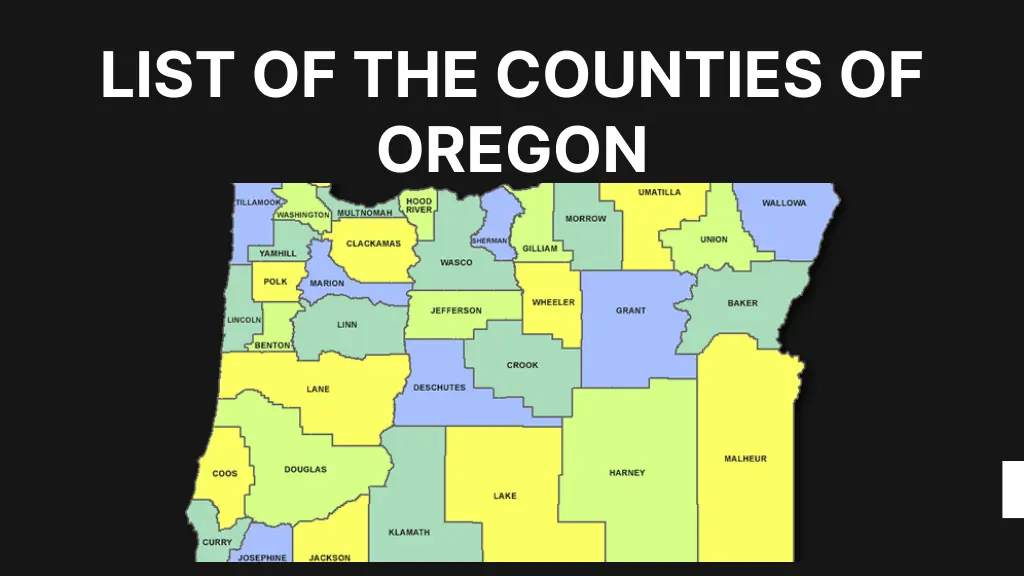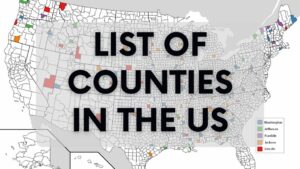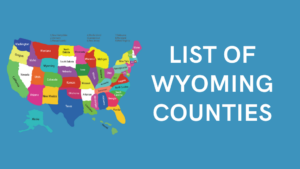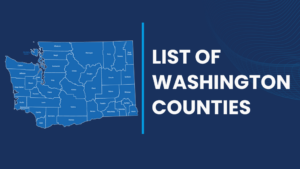Oregon, a state admired for its breathtaking landscapes and vibrant communities, is divided into thirty-six counties that together shape its governance, economy, and cultural identity. Each county has its own story, from the rugged coastal towns and fertile valleys to the bustling metropolitan centers and high desert plateaus. Exploring the list of counties in Oregon not only helps in understanding the administrative map but also reveals how local history, geography, and culture have influenced the state’s development.
Historical Background of Oregon’s County System
The county system in Oregon emerged during the mid-1800s, when pioneers traveled west along the Oregon Trail and settlement grew rapidly. The establishment of counties was necessary to manage law enforcement, land ownership, and taxation. Over time, boundaries shifted and new regions were carved out until Oregon reached its current total of thirty-six counties. These counties serve as important administrative units, providing essential services such as courts, public health, and infrastructure, while also preserving their individual historical and cultural character.
Geographic and Cultural Diversity
Oregon’s counties reflect the state’s immense diversity in both geography and culture. The western regions are known for lush valleys, dense forests, and agricultural richness, while the eastern side showcases the rugged beauty of high deserts and wide ranchlands.
County-by-County Overview of Oregon
Baker County
Baker County, located in the northeastern part of the state, is rich in mining history and outdoor adventure. The county seat, Baker City, is known for its historic architecture and proximity to the Oregon Trail Interpretive Center.
Benton County
Benton County, with Corvallis as its seat, is home to Oregon State University. The county blends academic vibrancy with agricultural roots and is known for innovation and environmental awareness.
Clackamas County
Clackamas County lies southeast of Portland and stretches from urban centers to Mt. Hood. It is known for diverse industries, outdoor recreation, and historic communities like Oregon City, the state’s first capital.
Clatsop County
Clatsop County rests on the northwest coast, with Astoria as its cultural hub. The county is famous for Lewis and Clark’s expedition history, fishing industries, and scenic Pacific coastlines.
Columbia County
Located along the Columbia River, Columbia County’s economy historically relied on timber and shipping. St. Helens serves as the county seat and reflects both historical charm and modern growth.
Coos County
Coos County, anchored by Coos Bay, has a strong maritime tradition. Fishing, shipping, and tourism are vital, with the Oregon Dunes National Recreation Area providing major outdoor attractions.
Crook County
Crook County, located in central Oregon, is dominated by ranching and agriculture. Prineville, the county seat, is known today as a growing hub for data centers and outdoor lifestyle.
Curry County
Curry County, positioned along the southern Oregon coast, offers dramatic scenery with rugged coastlines and river valleys. Gold Beach serves as the county seat, blending history with tourism.
Deschutes County
One of the fastest-growing counties in Oregon, Deschutes has Bend as its center. The county thrives on outdoor recreation, tourism, and modern development, drawing newcomers seeking quality of life.
Douglas County
Douglas County, with Roseburg as its seat, is historically tied to timber production. It is situated in southern Oregon and boasts scenic valleys, vineyards, and river systems.
Gilliam County
Gilliam County, one of Oregon’s least populated regions, relies heavily on agriculture and renewable energy. The seat, Condon, is a small community that reflects the rural character of eastern Oregon.
Grant County
Grant County is rich in natural beauty, with forests, ranchlands, and historic mining communities. Canyon City is the county seat, and the area remains sparsely populated but culturally significant.
Harney County
Harney County is Oregon’s largest by land area but has a very small population. Its seat, Burns, is surrounded by wide-open landscapes, high desert, and ranching traditions.
Hood River County
Hood River County, though small, is economically dynamic. With Hood River as its seat, the county thrives on fruit orchards, wineries, and outdoor sports like windsurfing along the Columbia Gorge.
Jackson County
Jackson County, located in southern Oregon, has Medford as its commercial hub and Ashland as a cultural center known for the Oregon Shakespeare Festival. Agriculture and tourism dominate its economy.
Jefferson County
Jefferson County is centered in central Oregon, with Madras as its seat. It is an agricultural region supported by irrigation and is also culturally rich with Native American heritage.
Josephine County
Josephine County, with Grants Pass as its seat, has strong ties to mining history and today thrives on tourism, river recreation, and arts.
Klamath County
Klamath County is anchored by Klamath Falls and boasts Crater Lake National Park as a major attraction. Agriculture, forestry, and energy also define the region.
Lake County
Lake County, one of Oregon’s most remote regions, relies on ranching and outdoor recreation. Its wide landscapes provide solitude and natural beauty.
Lane County
Lane County is home to Eugene, a major cultural and educational center with the University of Oregon. It combines urban life with rivers, forests, and mountains.
Lincoln County
Lincoln County lies along the central coast, with Newport as its seat. Fishing, tourism, and marine sciences are central to its identity.
Linn County
Linn County, located in the Willamette Valley, has Albany as its seat. The economy is historically tied to timber, agriculture, and manufacturing.
Malheur County
Malheur County, bordering Idaho, reflects eastern Oregon’s agricultural traditions. Ontario serves as its largest city and is important for trade and ranching.
Marion County
Marion County houses Salem, the state capital. It is one of Oregon’s most agriculturally productive counties and plays a central role in politics and governance.
Morrow County
Morrow County has Heppner as its seat and relies on agriculture, food processing, and energy development. Its rural communities continue to support farming traditions.
Multnomah County
Multnomah County, home to Portland, is Oregon’s smallest in land size but the largest in population. It is a hub of culture, trade, education, and innovation.
Polk County
Polk County, located in the Willamette Valley, has Dallas as its seat. It is known for vineyards, farming, and small-town charm.
Sherman County
Sherman County is one of Oregon’s least populated areas. Moro, the county seat, reflects its deep agricultural character and rural traditions.
Tillamook County
Tillamook County is a coastal region famous for its dairy production, forests, and maritime culture. The county seat, Tillamook, is renowned for its cheese and agricultural products.
Umatilla County
Umatilla County, in northeastern Oregon, is centered on Pendleton, known for its rodeo and wool industry. Agriculture, manufacturing, and trade play a large role here.
Union County
Union County, with La Grande as its center, thrives on agriculture, education, and outdoor recreation. Eastern Oregon University is a major influence in the region.
Wallowa County
Wallowa County is a scenic area in northeastern Oregon, with Enterprise as its seat. Known for the Wallowa Mountains and strong cultural traditions, it attracts outdoor enthusiasts and artists.
Wasco County
Wasco County, with The Dalles as its center, is an important trade and historical hub along the Columbia River. It combines agriculture, energy, and heritage tourism.
Washington County
Washington County is one of Oregon’s fastest-growing regions and home to the “Silicon Forest.” Hillsboro, its seat, has become a hub for technology companies.
Wheeler County
Wheeler County is Oregon’s least populated region. Fossil serves as its seat, and the area is known for ranching and paleontological sites.
Why the List of Counties in Oregon Matters
Counties in Oregon represent more than just geographic divisions. Each one carries the legacy of local history, cultural identity, and economic contributions. From timber and agriculture to technology and tourism, these regions form the backbone of Oregon’s governance and lifestyle. By understanding them, both residents and newcomers can appreciate how diverse communities thrive across the state.
FAQs
How many counties are in Oregon?
Oregon has a total of 36 counties, ranging from highly urbanized Multnomah County to sparsely populated Wheeler County.
What is the most populous county in Oregon?
Multnomah County is the most populous, home to Portland and the state’s largest metropolitan area.
What is the least populated county in Oregon?
Wheeler County is the least populated, known for its small communities and wide ranchlands.
Which county is the largest by land area?
Harney County is the largest by land area in Oregon, covering vast high desert landscapes.
Which county is the smallest by land area?
Multnomah County is the smallest by land size but has the highest population density.
Conclusion
Oregon’s thirty-six counties create a rich mosaic of culture, history, and economy that defines the state. From the bustling streets of Portland in Multnomah County to the wide deserts of Harney County, each region offers its own unique contributions. Exploring the list of counties in Oregon allows one to appreciate not only the administrative structure but also the diversity of lifestyles and landscapes across the state. For residents, visitors, or anyone considering moving to Oregon, understanding its counties provides valuable insight into the heart of this Pacific Northwest state.
Related Post:





